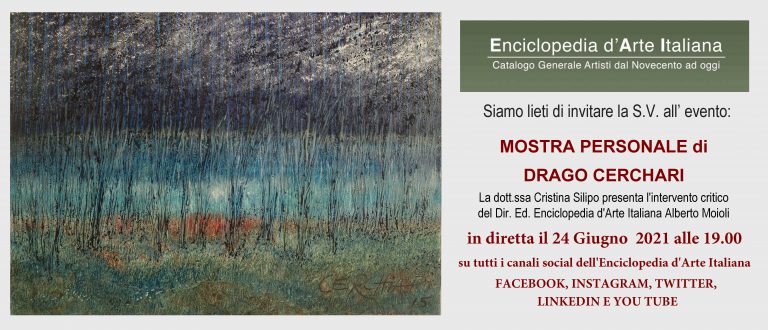Interview with Alberto Moioli
Welcome to artist Drago Cerchiari’s solo exhibition. The event will take place live on Facebook, Instagram, Linkedin, Twitter and YouTube involving a reputable audience in some thousands of people. I now leave the floor to Prof. Alberto Moioli who will illustrate the artist’s works.
With Drago Cerchiari I am a privileged person, because I had the opportunity to follow him closely thanks to his inclusion in the volume of the Enciclopedia d’Arte Italiana from the beginning, This has allowed me to follow the content but above all stylistic evolution of the artist, up to the present day. I then remember with real pleasure the solo exhibition of Drago Cerchiari that I curated inside the authoritative halls of the Museum of Art and Science of Milan , a very interesting exhibition that marked a particular passage of his artistic history.
Prof. Moioli, having closely followed the artist in his cultural career, you were able to appreciate the stylistic evolution of his production, but how did all this begin?
The vision on the master Drago Cerchiari is a global vision with a very important and heavy international connotation throughout his history, we consider that shortly before the age of thirty he left Italy and went to live and work, to create art, to Princeton in the United States, in New Jersey, in a place particularly steeped in art and culture, it should be considered that one of the most important universities in the world is located here and there is also a museum where many Italian works are kept, including also a work by Pietro da Cortona which is particularly important also from a historical point of view.
Drago Cerchiari therefore has this international connotation but we must consider that his studios, his places where he painted and created the works, which we can admire today, are scattered all over the world, Lausanne in Switzerland, Pre San Didier in Italy, in Val d’Aosta, in the woods of these wonderful mountains but also on the beach of Chia, exactly in Santa Margherita di Pula, Sardinia.
Critics have sometimes spoken of the artist as an exponent of historical currents including verism. Do you agree to include the artist in this authoritative movement?
I believe that sometimes, to classify, insert, lock up an artist within a movement means to limit and trivialize his poetics, I believe that Drago Cerchiari has stylistic and content characteristics that go beyond all this, managing to connote themselves in a unique and particularly personalized and personal context. This is why when we talk about characters like Drago Cerchiari, we must try to go beyond the surface, beyond what we can observe as an initial aesthetic, graphic impact, without dwelling only on the coloristic, chromatic part, which fascinate everyone. I particularly love the use of his Payne gray which is that leaden gray that he knows how to use in a masterly way, but beyond all this, there is a poetic, a lyric that characterizes and identifies him in the world because we have already seen his marked international connotation. I take as an example the famous “Mario’s chairs”, this is a very interesting work that not only represents a chair by the sea on a blue background, but tells us about the hours of the day, it represents, as he says, a flower, that is, through this chair he manages to create a real metaphor of life, the chair is positioned on the sand, surely we are in Santa Margherita di Pula in Sardinia, and inside this work we can see a real scannig of the hours, on this chair in fact the light changes, because it changes naturally during the day, this chair during the day undergoes the rising of the wind and therefore is ideally and materially soiled by the sand that rises, and all this is noticed through the process of opening and closing of the chair, just like a flower, but above all a metaphor of life emerges that speaks of time, tells us of the transience of life, tells us a lot but only if we can observe it not in a few seconds. And this is another of those aspects that we could face thinking that often we look at works in a few seconds when instead some of these have been realized in many months not only of painting but also of thought. And when we have to go beyond the simple classification, perhaps linked to an artistic movement, what we can appreciate therefore is not only the graphic – aesthetic aspect but it is that something that takes us beyond the canvas, in the direction linked to the world of emotions.
We thank Prof. Moioli for his speech and we meet the kind public who followed us at the next exhibition of the Enciclopedia d’Arte Italiana.
